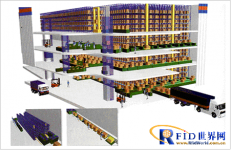
RFID warehouse logistics management system
[ad_1]
I. Overview
Warehouse management plays a very important role in the entire management process of an enterprise. If timely and accurate purchase, inventory control and delivery are not guaranteed, it will bring huge losses to the enterprise, which is not only manifested in the increase in various management expenses of the enterprise. , And it will make it difficult to guarantee the quality of customer service, and ultimately affect the market competitiveness of the company.
Traditional warehouse management generally relies on a non-automated paper document-based system to record and track incoming and outgoing goods. The internal management of the warehouse is completely implemented manually. Therefore, the efficiency of warehouse management is extremely low, and the warehouse that can be managed The scale is also very small.
With the popularization of computer applications, most of the enterprise warehouse management data materials have begun to use computer data systems for management, but the data is still collected and statistically organized by first recording on paper and then manually inputting it into the computer. This not only causes a lot of waste of human resources, but also due to human factors, the data entry speed is slow and the accuracy rate is low.
With the continuous development of the scale of the enterprise, the number of types of materials managed by the warehouse is increasing, and the frequency of in and out of the warehouse has increased sharply. Warehouse management operations have also become very complex and diversified. The traditional manual warehouse operation mode and data collection method have been unable to meet the requirements of the warehouse. The rapid and accurate requirements of management have seriously affected the efficiency of the operation of the enterprise and become a major obstacle to the development of the enterprise.

The RFID-based warehouse management system introduces RFID technology into the existing warehouse management, and automatically collects the data of each operation link such as warehouse arrival inspection, warehousing, outgoing, allocation, shifting, inventory counting, etc. Ensure the speed and accuracy of data input in all aspects of warehouse management, ensure that enterprises grasp the real data of inventory in a timely and accurate manner, and reasonably maintain and control enterprise inventory. Through scientific coding, it is also convenient to manage the batch and shelf life of items. Using the system’s location management function, you can also grasp the current location of all inventory materials in a timely manner, which is conducive to improving the efficiency of warehouse management.
After adopting RFID technology, it will bring the following benefits to enterprises:
(1) Save the cost of manual data collection;
(2) Automated warehouse management operations to improve work efficiency;
(3) Reduce management costs and human errors;
(4) More precise control of import, sale and inventory;
(5) Enhance partnerships;
(6) Quickly respond to customer needs and expand product sales.
2. RFID system architecture
The warehouse management system design adopts the following three-tier architecture:
The first layer is Capture, which mainly collects data through radio frequency identification equipment and other automatic identification equipment, including location tags, cargo tags, wireless data terminals, AGV vehicles, etc.;
The second layer is Movement, that is, through wireless communication technology, the collected data is transferred to the central database, including wireless access equipment and related network equipment.
The third layer is Management, which manages the collected data, including database servers, network servers and other equipment and warehouse management system software.

System Components:

The warehouse management information system consists of three parts:
(1) Warehouse management center subsystem
Responsible for the centralized management and maintenance of the warehouse management database, responsible for the formulation and ordering of purchase plans and outbound plans; print and generate various management reports.
(2) Warehouse management field subsystem
Issue storage labels, perform real-time inventory management (location management), and issue warehouse management instructions through the wireless network.
(3) Warehouse management execution subsystem
Complete specific operations such as storage, storage, removal, inventory, etc., and return to the live execution.
The information flow of the system is as follows:

[ad_2]



